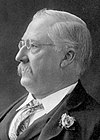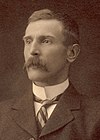Regierung Reid-McLean

Die Regierung Reid-McLean war die vierte Regierung von Australien. Sie amtierte vom 18. August 1904 bis zum 5. Juli 1905. Sie war die erste australische Regierung unter Führung der Free Trade Party.
Ihre Vorgängerregierung, eine von der Protectionist Party unterstützte Minderheitsregierung der Australian Labor Party unter Premierminister Chris Watson, scheiterte, wie auch schon die Regierung Deakin I, am Streit um die Details der conciliation and arbitration bill.[1] George Reid, der Führer der Free Trade Party, wurde neuer Premierminister einer Koalition von Free Trade Party und Protectionist Party. Alfred Deakin, der Führer der Protectionists, unterstützte die Regierung, weigerte sich aber dem Kabinett beizutreten. Über die Frage der Regierungsunterstützung kam es zu einer Spaltung der Protectionists, von denen ungefähr die Hälfte die Labor-Opposition unterstützen, wodurch die Regierung nur noch über eine Mehrheit von einer Stimme im Repräsentantenhaus verfügte. Im Juni 1905 entzog Deakin der Regierung seine Unterstützung und bildete, toleriert durch die Labor Party, eine neue Regierung.[2][3]
Ministerliste
| Amt | Minister | Partei | Amtszeit | Bild |
|---|---|---|---|---|
| Premierminister und Außenminister | George Reid | Free Trade Party | 18. August 1904 – 5. Juli 1905 |  |
| Minister für Handel und Zölle | Allan McLean | Protectionist Party | 18. August 1904 – 5. Juli 1905 |  |
| Generalstaatsanwalt | Josiah Symon | Free Trade Party | 18. August 1904 – 5. Juli 1905 |  |
| Schatzminister | George Turner | Protectionist Party | 18. August 1904 – 5. Juli 1905 |  |
| Innenminister | Dugald Thomson | Free Trade Party | 18. August 1904 – 5. Juli 1905 |  |
| Verteidigungsminister | James Whiteside McCay | Protectionist Party | 18. August 1904 – 5. Juli 1905 |  |
| Generalpostmeister | Sydney Smith | Free Trade Party | 18. August 1904 – 5. Juli 1905 |  |
| Vizepräsident des Executive Council | James Drake | Protectionist Party | 18. August 1904 – 5. Juli 1905 |  |
Weblinks
- Parliamentary Handbook for the 45th Parliament. (PDF; 13,4 MB) Part 6: Historical information on the Australian Parliament – Ministries and Cabinets. Parliament of Australia, S. 520, abgerufen am 14. April 2019 (englisch).
Einzelnachweise
- ↑ Bede Nairn: Watson, John Christian (Chris) (1867–1941). In: Douglas Pike (Hrsg.): Australian Dictionary of Biography. Band 12. Melbourne University Press, Carlton (Victoria) 1990, ISBN 0-522-84437-5 (englisch).
- ↑ R. Norris: Deakin, Alfred (1856–1919). In: Douglas Pike (Hrsg.): Australian Dictionary of Biography. Band 8. Melbourne University Press, Carlton (Victoria) 1981, ISBN 0-522-84219-4 (englisch).
- ↑ W. G. McMinn: Reid, Sir George Houstoun (1845–1918). In: Douglas Pike (Hrsg.): Australian Dictionary of Biography. Band 11. Melbourne University Press, Carlton (Victoria) 1988, ISBN 0-522-84380-8 (englisch).
Auf dieser Seite verwendete Medien
Photograph of members of the Watson Ministry. Back row (L-R): Andrew Fisher, Minister for Trade and Customs; Anderson Dawson, Minister for Defence; Gregor McGregor, Vice-President of the Executive Council; Hugh Mahon, Postmaster-General. Front row (L-R): Henry Bournes Higgins, Attorney-General; Chris Watson, Prime Minister; Lord Northcote, Governor-General; Billy Hughes, Minister for External Affairs; Lee Batchelor, Minister for Home Affairs.
Autor/Urheber: Reid, G. H. (George Houstoun), Sir, 1845-1918, Lizenz: No restrictions
Identifier: australiafiscalp00reid (find matches)
Title: Australia and the fiscal problem ..
Year: 1903 (1900s)
Authors: Reid, G. H. (George Houstoun), Sir, 1845-1918
Subjects: Tariff -- Australia Free trade
Publisher: London : Sir Joseph Causton & Sons, Ltd.
Contributing Library: University of California Libraries
Digitizing Sponsor: MSN
View Book Page: Book Viewer
About This Book: Catalog Entry
View All Images: All Images From Book
Click here to view book online to see this illustration in context in a browseable online version of this book.
Text Appearing Before Image:
The answer to the firstquestion is they do not need it, as is shown bytheir ability to export their manufactures atequivalent prices to those quoted by British andforeign manufacturers. The answer to thesecond question is that, being able to compete inoutside markets, they could the more readilycompete with the foreigner in their own werethere no duty; but there being a duty of 50 to75 per cent, against the foreigner the opportunityof annexing the splendid profit that duty offersis too good to be lost. It might be lost, and theconsumers greatly benefit, if the manufacturerswithin the States were left to keenly contestamongst themselves ; but here arises the chanceof manipulation. Negotiations are openedbetween the manufacturers, a ring or trust isformed which binds or buys all the manu-facturers, arrangements are made to fight off anynew competition which may be attracted to thefield, unnecessary works are shut down, and theseparate competitors become one in interest andin operation.
Text Appearing After Image:
Rembrandt Studios, Block Arcade, Melbourne Copyright Mr. UUGALD THOMSON, M.P. A RING FENCE 19 The Advantage of the Few. In many instances the saving effected by thisconcentration of effort would in itself constitutea handsome profit, and were the combinationsatisfied with that the public would not complain.But why be satisfied when a friendly Govern-ment and a long-suffering people offer so muchmore ? Combination having replaced com-petition within the United States, and theoutside competitor being subject to a 50 to75 per cent, duty, why not take full advantageof that duty, and obtain from 50 to 75 per cent,additional profit ? That is the principal objectof amalgamation and it is usually achieved. The enormous advantage to a few manu-facturers can be at once appreciated, but whatis the result to that far larger body—theAmerican consumers ? They are already en-during the high duties on such of their suppliesas come from abroad in spite of the tariff, andwhich yield the large United
Note About Images
Allan McLean, 19th Premier of Victoria, later Minister for Trade and Customs of Australia.
George Reid, Prime Minister of Australia
Commonwealth Coat of Arms of Australia granted by Royal Warrant signed by King George V on 19 September 1912.
IMPORTANT:This image is an artist's interpretation of the original (1912) official version of the Commonwealth Coat of Arms shown in Commons on the Australian coat of arms page. A variant of the original, with a transparent background, is shown on this page.
| “ | Quarterly of six, the first quarter Argent a Cross Gules charged with a Lion passant guardant between on each limb a Mullet of eight points Or; the second Azure five Mullets, one of eight, two of seven, one of six and one of five points of the first (representing the Constellation of the Southern Cross) ensigned with an Imperial Crown proper; the third of the first a Maltese Cross of the fourth, surmounted by a like Imperial Crown; the fourth of the third, on a Perch wreathed Vert and Gules an Australian Piping Shrike displayed also proper; the fifth also Or a Swan naiant to the sinister Sable; the last of the first, a Lion passant of the second, the whole within a Bordure Ermine; for the Crest on a Wreath Or and Azure A Seven-pointed Star Or, and for Supporters dexter a Kangaroo, sinister an Emu, both proper. | ” |









